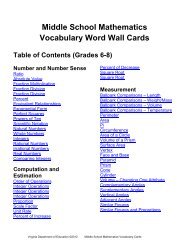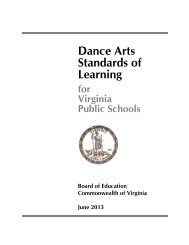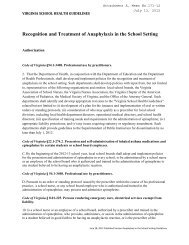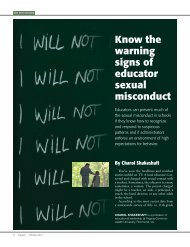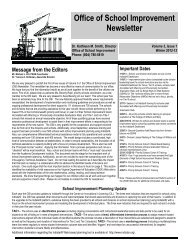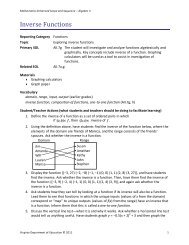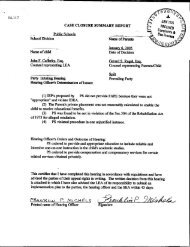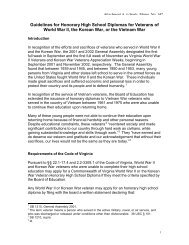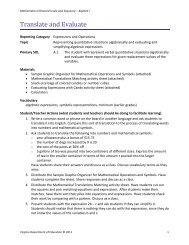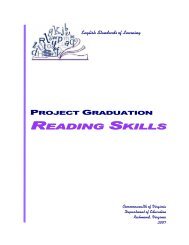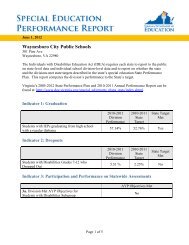Fine/Gross Motor Screening - Virginia Department of Education
Fine/Gross Motor Screening - Virginia Department of Education
Fine/Gross Motor Screening - Virginia Department of Education
Create successful ePaper yourself
Turn your PDF publications into a flip-book with our unique Google optimized e-Paper software.
VIRGINIA SCHOOL HEALTH GUIDELINES<br />
195<br />
<strong>Fine</strong>/<strong>Gross</strong> <strong>Motor</strong> <strong>Screening</strong><br />
Authorization<br />
Code <strong>of</strong> <strong>Virginia</strong>, Section 22.1-214, Board to Prepare Special <strong>Education</strong> Program for<br />
Children with Disabilities.<br />
Excerpt: See Appendix A for Code <strong>of</strong> <strong>Virginia</strong>, § 22.1-214.<br />
Regulations. <strong>Virginia</strong> <strong>Department</strong> <strong>of</strong> <strong>Education</strong> (Effective January 1994). Regulations<br />
Governing Special <strong>Education</strong> Programs for Children with Disabilities in <strong>Virginia</strong>.<br />
Richmond, Va.: Author.<br />
Excerpt: Part III: Responsibilities <strong>of</strong> LEAS and State Agencies.<br />
§3.2 Identification, Evaluation, and Eligibility.<br />
C. <strong>Screening</strong>.<br />
2. The screening process for all children enrolled in the school division<br />
is as follows:<br />
a. All children within 60 administrative working days <strong>of</strong> initial<br />
enrollment in a public school, shall be screened in the following<br />
areas to determine if formal assessment is indicated:<br />
(1) Speech, voice, and language; and<br />
(2) Vision and hearing.<br />
b. All children (through grade three), within 60 administrative<br />
working days <strong>of</strong> initial enrollment in public schools, shall be<br />
screened for fine and gross motor functions to determine if formal<br />
assessment is indicated.<br />
c. Specific measures or instruments will be employed which use:<br />
(1) Both observational and performance techniques; and<br />
(2) Techniques which guarantee non-discrimination.<br />
Recommendation<br />
Purpose. Basic gross and fine motor screening is crucial in determining if the student is<br />
developing within the “normal range.” The five areas that need to be screened to ensure
196<br />
normal development include balance, bilateral coordination, upper extremity<br />
coordination, visual motor control, and upper extremity speed and dexterity. <strong>Fine</strong> and<br />
gross motor skills are essential building blocks to educational success.<br />
The screening also allows the parents and administrators to be notified when any student<br />
shows signs <strong>of</strong> a significant impairment that should be followed up by a physician. It also<br />
gives information to teachers and parents regarding delays in development <strong>of</strong> gross and<br />
fine motor skills <strong>of</strong> the child.<br />
Procedure<br />
Materials. The following materials are used for the K-3 screening:<br />
♦ Playground ball (8 1/2 inches).<br />
♦ Playground ball (4 to 5 inches).<br />
♦ Piece <strong>of</strong> paper with a circle.<br />
♦ Piece <strong>of</strong> paper with a curved path that is<br />
3/4-inch wide.<br />
♦ Pegboard.<br />
♦ Ten small pegs.<br />
♦ Stopwatch.<br />
Criteria. The criteria for failing the fine and gross motor screening is that the student<br />
must fail two out <strong>of</strong> the three gross motor sections and both <strong>of</strong> the fine motor skills. The<br />
evaluation sheet should have two sections: one for comments and one for pass/fail. The<br />
student is allowed two attempts to pass each skill.<br />
Five <strong>Screening</strong> Areas. The five areas that need to be screened to ensure normal<br />
development include:<br />
♦ Balance.<br />
♦ Bilateral coordination.<br />
♦ Upper extremity coordination.<br />
<strong>Gross</strong> <strong>Motor</strong> Skills.<br />
♦ Visual motor control.<br />
♦ Upper extremity speed and dexterity.<br />
1. Balance<br />
♦ Kindergarten: To pass, the child must be able to hold the right foot <strong>of</strong>f the ground<br />
for 5 seconds, place it down, and hold the left foot <strong>of</strong>f the ground for 5 seconds.<br />
♦ Grades 1 and 2: To pass, the child must hold the right foot <strong>of</strong>f the ground for 10<br />
seconds, place it down, and hold the left foot <strong>of</strong>f the ground for 10 seconds.<br />
♦ Grade 3: To pass, the child must hold the right foot <strong>of</strong>f the ground for 12 seconds,<br />
place it down, and hold the left foot <strong>of</strong>f the ground for 12 seconds.<br />
196
194<br />
2. Bilateral Coordination<br />
♦ Kindergarten, Grades 1 and 2: To pass, the student must be able to jump in the air<br />
and clap their hands while airborne five times consecutively.<br />
♦ Grade 3: To pass, the child must be able to jump in the air and touch both heels<br />
with both hands during two out <strong>of</strong> three trials.<br />
(Examiners should note if the child is unable to perform the claps and jumps in an<br />
integrated fashion and if there are any overflow reactions in facial features)<br />
3. Upper Extremity Coordination<br />
♦ Kindergarten and Grade 1: To pass, the child must toss an 8 1/2-inch playground<br />
ball in the air and catch it five consecutive times. The ball must leave the hands<br />
and may be trapped in the body.<br />
♦ Grades 2 and 3: To pass, the child must toss a 4- to 5-inch ball into the air and<br />
catch it with hands, five times consecutively, with their hands only.<br />
(Examiners should note if the ball does not go above the child’s head, if the child<br />
stays stationary to catch the ball, and/or if the ball is tossed straight in the air.)<br />
<strong>Fine</strong> <strong>Motor</strong> Skills.<br />
1. Visual <strong>Motor</strong> Skills<br />
♦ Kindergarten: To pass, the child must copy a circle and make predominantly<br />
circular lines. (See Figure 1 at the end <strong>of</strong> this section.)<br />
♦ Grades 1, 2, and 3: To pass, the child must draw a line within a curved path<br />
without making more than two deviations from the curved line. (See Figure 2 at<br />
the end <strong>of</strong> this section.)<br />
(Examiners should note if the child is unable to grasp a pencil properly, does not<br />
rotate the paper, and/or if the pencil stays on the paper while the child is duplicating<br />
the circle or the path.)<br />
2. Upper Extremity Speed and Dexterity<br />
♦ Kindergarten: To pass, the child must place five pegs, using one hand, into a<br />
pegboard within 30 seconds.<br />
♦ Grades 1 and 2: To pass, the child must place five pegs, using one hand, into a<br />
pegboard within 20 seconds.<br />
♦ Grade 3: To pass, the child must place five pegs, using one hand, into a pegboard<br />
within 15 seconds.<br />
(Examiners should note if the child picks/does not pick up the pegs one at a time,<br />
drops the pegs, does not stabilize the pegboard with one hand, and/or does not use the<br />
proper pincer grasp on the pegs.)<br />
194
VIRGINIA SCHOOL HEALTH GUIDELINES<br />
195<br />
Referral and Follow-Up Process. Examiners should document the results <strong>of</strong> the child’s<br />
testing, make referrals when the child is unable to meet the screening guidelines, and<br />
place all test results in the child’s school record. If the student fails the screening, referral<br />
is made to the Child Study Committee for recommendations for further evaluation. It is<br />
important to document the fact that a student has difficulty in a particular area <strong>of</strong> the<br />
screening or fails the screening. The administration needs to be involved with the<br />
parents/guardians in helping the student.<br />
<strong>Gross</strong> <strong>Motor</strong> Functions:<br />
Summary <strong>of</strong> <strong>Fine</strong>/<strong>Gross</strong> <strong>Motor</strong> <strong>Screening</strong><br />
Skill Grade <strong>Screening</strong> Test<br />
Balance K Balance on each foot for 5 seconds.<br />
Bilateral Coordination 1-3 Balance on each foot for 10 seconds.<br />
<strong>Fine</strong> <strong>Motor</strong> Functions K-3 Jumping up and down on two feet and landing on<br />
both feet while clapping hands.<br />
Upper Extremity Coordination K-3 Toss and catch ball or bounce and catch, five times.<br />
<strong>Fine</strong> <strong>Motor</strong> Functions:<br />
Skill Grade <strong>Screening</strong> Test<br />
Visual <strong>Motor</strong> Control K Copy a circle. (See Figure 1 on following page.)<br />
Upper Extremity Speed &<br />
Coordination<br />
1-3 Draw a line within a curved path. (See Figure 2 on<br />
following page.)<br />
K-3 Sort cubes or pegs; or, string beads.<br />
Documentation<br />
Recording Recommendation. A record <strong>of</strong> the fine and gross motor screenings <strong>of</strong> each<br />
student can be kept by recording the results on the following form:<br />
♦ Cumulative Health Record (Form LF.009).<br />
Copy <strong>of</strong> Form. See Appendix D for a copy <strong>of</strong> the following form:<br />
♦ Cumulative Health Record (Form LF.009).<br />
Figure 1.
196<br />
Figure 2.<br />
X<br />
196
VIRGINIA SCHOOL HEALTH GUIDELINES<br />
197<br />
Hearing <strong>Screening</strong><br />
Authorization<br />
Code <strong>of</strong> <strong>Virginia</strong>, Section 22.1-273, Sight and Hearing <strong>of</strong> Pupil to be Tested. The<br />
Code <strong>of</strong> <strong>Virginia</strong> requires that within the time periods and at the grades provided in<br />
regulations promulgated by the Board <strong>of</strong> <strong>Education</strong>, the principal <strong>of</strong> each such school<br />
shall cause the sight and hearing <strong>of</strong> the relevant pupils in the school to be tested, unless<br />
such students are pupils admitted for the first time to a public kindergarten or elementary<br />
school who have been so tested as part <strong>of</strong> the comprehensive physical examination<br />
required by § 22.1-270 or the parents or guardians <strong>of</strong> such students object on religious<br />
grounds and the students show no obvious evidence <strong>of</strong> any defect or disease <strong>of</strong> the eyes<br />
or ears.<br />
Excerpt: See Appendix A for Code <strong>of</strong> <strong>Virginia</strong>, § 22.1-273.<br />
Code <strong>of</strong> <strong>Virginia</strong>, Section 22.1-214, Board to Prepare Special <strong>Education</strong> Program for<br />
Children with Disabilities.<br />
Excerpt:<br />
The Board <strong>of</strong> <strong>Education</strong> shall prepare and supervise the implementation<br />
by each school <strong>of</strong> a program <strong>of</strong> special education designed to educate and<br />
train children with disabilities between the ages defined in § 22.2-213 and<br />
may prepare and place in operation such program for individuals <strong>of</strong> other<br />
ages…The program shall require (i) that the hearing <strong>of</strong> each disabled<br />
child be tested prior to placement in a special education program and (ii)<br />
that a complete audiological assessment, including tests which will assess<br />
inner and middle ear functioning, be performed on each child who is<br />
hearing impaired or who fails the test required in clause(i).<br />
Regulations. <strong>Virginia</strong> <strong>Department</strong> <strong>of</strong> <strong>Education</strong> (Effective January 1994). Regulations<br />
Governing Special <strong>Education</strong> Programs for Children with Disabilities in <strong>Virginia</strong>.<br />
Richmond, Va.: Author.<br />
Excerpt: Part III: Responsibilities <strong>of</strong> LEAS and State Agencies.<br />
§3.2 Identification, Evaluation, and Eligibility.<br />
C. <strong>Screening</strong>.<br />
2. The screening process for all children enrolled in the school<br />
division is as follows:<br />
a. All children within 60 administrative working days <strong>of</strong> initial<br />
enrollment in a public school, shall be screened in the
198<br />
following areas to determine if formal assessment is<br />
indicated:<br />
(1) Speech, voice, and language; and<br />
(2) Vision and hearing.<br />
b. All children (through grade three), within 60 administrative<br />
working days <strong>of</strong> initial enrollment in public schools, shall be<br />
screened for fine and gross motor functions to determine if<br />
formal assessment is indicated.<br />
c. Specific measures or instruments will be employed which use:<br />
E. Evaluation<br />
(1) Both observational and performance techniques; and<br />
(2) Techniques which guarantee non-discrimination.<br />
5. The LEA shall establish procedures to ensure<br />
a. That each child is assessed by a qualified pr<strong>of</strong>essional in all<br />
areas related to the suspected disability, including, where<br />
appropriate, health, vision, hearing, social and emotional<br />
status, general intelligence, academic performance,<br />
communicative status, and motor abilities. This may include<br />
educational, medical, sociocultural, psychological, or<br />
developmental assessments. Reports from assessments must<br />
be provided in writing. However, the hearing <strong>of</strong> each child<br />
with a disability shall be tested during the eligibility process<br />
prior to be placement in a special education program. A<br />
complete audiological assessment, including tests which will<br />
assess inner and middle ear functioning, must be performed<br />
on each child who fails two hearing screening tests. The<br />
second hearing screening test shall be completed not less than<br />
15 nor more than 45 calendar days after administration <strong>of</strong> the<br />
first screening test.<br />
SUPTS. MEMO. SUPTS. MEMO. No. 159, August 19, 1987, Subject: Procedure for<br />
Implementing School Law 22.1-273. (See Appendix A for copy <strong>of</strong> SUPTS. MEMO.)<br />
Excerpt:<br />
Because all children are required to have a physical examination<br />
when they first enter school, it was determined that this requirement<br />
would provide adequate screening for kindergarten students.<br />
Therefore, the only health screening required to be done for pupils<br />
will be for sight and hearing defects in grades 3, 7, and 10.<br />
198
VIRGINIA SCHOOL HEALTH GUIDELINES<br />
199<br />
SUPTS. MEMO. SUPTS. MEMO. No. 168, September 2, 1987, Subject: Procedure for<br />
Implementing School Law 22.1-273. (See Appendix A for copy <strong>of</strong> SUPTS. MEMO.)<br />
Excerpt:<br />
Existing Board <strong>of</strong> <strong>Education</strong> regulations as specified in Regulations<br />
Governing Special <strong>Education</strong> Programs in Handicapped Children<br />
and Youth in <strong>Virginia</strong>, September 1984 stipulate that:<br />
All children, within 60 administrative working days <strong>of</strong><br />
initial enrollment in a public school, shall be screened<br />
in the following areas to determine if formal<br />
assessment is indicated: (a) speech, voice, and<br />
language; (b) fine and gross motor functions; and (c)<br />
vision and hearing.<br />
Additional screening for vision and hearing should now occur in<br />
grades 3, 7, and 10.<br />
Summary. In <strong>Virginia</strong>, hearing screening is required as follows:<br />
♦ Component <strong>of</strong> the School Entrance Health Form: Part II – Comprehensive Physical<br />
Examination Report. (See Code <strong>of</strong> <strong>Virginia</strong>, § 22.1-270.)<br />
♦ Grades 3, 7, and 10—unless tested as part <strong>of</strong> the School Entrance Health Form: Part<br />
II – Comprehensive Physical Examination Report. (See Code <strong>of</strong> <strong>Virginia</strong>, § 22.1-<br />
273.)<br />
♦ All children within 60 administrative working days <strong>of</strong> initial enrollment in a public<br />
school (see Regulations Governing Special <strong>Education</strong> Programs for Children with<br />
Disabilities in <strong>Virginia</strong>, effective January 1994).<br />
♦ The hearing <strong>of</strong> each child with a disability shall be tested during the eligibility<br />
process prior to be placement in a special education program (see Regulations<br />
Governing Special <strong>Education</strong> Programs for Children with Disabilities in <strong>Virginia</strong>,<br />
effective January 1994).<br />
Overview<br />
The purpose <strong>of</strong> a school hearing screening program is to identify students with a hearing<br />
loss that may impact their intellectual, emotional, social, speech, and/or language<br />
development. The subtlety <strong>of</strong> a hearing loss may lead to a child’s hearing loss being<br />
overlooked. The school’s hearing screening program can play an important role in<br />
ensuring no student has a hearing loss that goes undetected and unmanaged, resulting in<br />
further developmental or academic delays. Even mild hearing losses may be<br />
educationally and medically significant. An undetected hearing loss may result in:<br />
♦ A delay in speech and language skills.
200<br />
♦ Language deficits, which may lead to learning problems and limited academic<br />
achievement.<br />
♦ Difficulties in communication, which may lead to social isolation and poor selfconcept,<br />
resulting in emotional or behavioral problems.<br />
♦ A negative impact on the child’s vocational and educational choices.<br />
♦ Behavioral problems.<br />
Most children with significant hearing loss are identified prior to school entry. Research<br />
indicates that the critical period for screening is birth to 3 years, as auditory stimuli<br />
during this period appear to be critical to development <strong>of</strong> speech and language skills.<br />
However, conductive hearing loss in pre-school and school-age children related to otitis<br />
media (middle ear infection) that although, if treated, is temporary in nature, can cause<br />
hearing loss. Due to this possibility and the incidence <strong>of</strong> childhood hearing loss that has<br />
not been detected, hearing screening in the school setting can prevent the negative impact<br />
any hearing loss might have on a child’s ability to communicate effectively and achieve<br />
academically. Hearing screenings at older age levels are important to identify noiseinduced<br />
hearing loss.<br />
Note. The incidence <strong>of</strong> significant permanent (sensorineural) hearing loss in newborns is<br />
approximately 6 in 100 live births. With the implementation <strong>of</strong> universal newborn<br />
hearing screening in the state <strong>of</strong> <strong>Virginia</strong>, the majority <strong>of</strong> newborns with significant<br />
congenital hearing loss should be identified within the first month <strong>of</strong> life and entered into<br />
the state’s follow-up program.<br />
American Academy <strong>of</strong> Pediatrics, American-Speech-Language Hearing Association<br />
and Bright Futures Recommendations. The American Academy <strong>of</strong> Pediatrics (AAP)<br />
recommends objective hearing testing at ages 3, 4, 5, 10, 12, 15, and 18. 78 Bright<br />
Futures 79 concurs with these recommendations up to age 12 and recommends that<br />
adolescents exposed to loud noses, with recurrent ear infections, or who report problems<br />
should receive objective testing. The American Speech-Language-Hearing Association<br />
(ASHA) has recommended annual pure-tone audiometry testing for all children at high<br />
risk for hearing impairment. 80<br />
78 American Academy <strong>of</strong> Pediatrics Committee on Practice and Ambulatory Medicine. (1995).<br />
Recommendations for Preventive Pediatric Health Care. Pediatrics, 96, pp. 373-374.<br />
79 Green, M. (1994). Bright Futures Guidelines for Health Supervision <strong>of</strong> Infants, Children, and<br />
Adolescents. Arlington, Va.: National Center for <strong>Education</strong> in Maternal and Child Health.<br />
80 American Speech-Language-Hearing Association. (1985). Guidelines for Identification Audiometry.<br />
ASHA, 27, pp. 49-52.<br />
200
VIRGINIA SCHOOL HEALTH GUIDELINES<br />
201<br />
History. A family and medical history <strong>of</strong> every child to be screened should be assessed<br />
for risk factors for hearing impairment. Whenever possible, parents should be asked<br />
about the auditory responsiveness and speech and language development <strong>of</strong> their child.<br />
Parental reports <strong>of</strong> impairment should be seriously evaluated. If this is not possible,<br />
when the results <strong>of</strong> the hearing screening indicate a problem or potential problem, the<br />
past medical history recorded on the school entrance physical examination should be<br />
evaluated for changes over time.<br />
Recommendation<br />
Procedure and Personnel. Each school division may set a policy, assigning the<br />
personnel responsible for completion <strong>of</strong> hearing screening. Speech-language pathologists<br />
and audiologists are qualified to conduct hearing screening programs. Certification<br />
programs for hearing screening are available for other personnel. Non-certified<br />
personnel responsible for the screening program should receive instruction in the proper<br />
techniques to be used. Training should be conducted by a currently licensed audiologist.<br />
Personnel conducting the screening should give an explanation <strong>of</strong> the test procedure to<br />
the class as a group, and individually as needed, prior to the testing to assure that students<br />
understand the purpose and process. Individual screening is required as group screening<br />
is not valid.<br />
Care should be taken to choose a site for the testing that is in the quietest part <strong>of</strong> a<br />
building. Environmental noise levels should be low enough to allow a person with<br />
normal hearing to easily hear the pure tone frequencies through the ear phones. A<br />
soundpro<strong>of</strong> room is preferable, if available.<br />
Guidelines for Pure Tone <strong>Screening</strong>. The pure tone audiometer is used in school-based<br />
screening programs and must meet the standards for screening audiometers established<br />
by the American National Standards Institute (ANSI). It should have the air conduction<br />
frequencies <strong>of</strong> 500, 1000, 2000, and 4000 Hertz. Proper handling <strong>of</strong> these machines is<br />
required, with at least yearly calibration, in order to ensure accurate readings. The<br />
following are general steps for using a pure tone audiometer for testing hearing.<br />
1. The examiner should turn on the machine and listen to screening tones to assure that<br />
audiometer is properly functioning, making sure to listen to both right and left<br />
earphones. (The recommendation is that the individual responsible for the<br />
audiometer should listen to it each day to detect gross abnormalities.) If screening is<br />
being done throughout the day, leave the audiometer on to avoid having to wait for<br />
the machine to warm up.<br />
2. Have the student sit down positioned so he/she cannot see the examiner operate the<br />
audiometer.<br />
3. Give clear, concise instructions. For example, “You are going to wear earphones.”<br />
“You will hear beeps. They will be quiet (s<strong>of</strong>t) so you will have to listen carefully.
202<br />
Please indicate when you hear the beep by immediately raising your hand.” “Please<br />
put your hand down when you no longer hear the beep. You will hear a louder sound<br />
first to let you hear clearly what you are listening for, then the sounds will be s<strong>of</strong>ter<br />
for testing.”<br />
4. Have the student remove glasses and large earrings. Be sure student is not chewing<br />
food, candy, or gum.<br />
5. Place earphones on each ear (red earphone over student’s right ear; blue earphone<br />
over student’s left ear). Be sure that the earphones fit snugly and that nothing<br />
interferes with the passage <strong>of</strong> sound (remove hair from between earphone and ear).<br />
6. Set the Hearing Threshold Level at 20 dBHL and the frequency at 1000 Hz. Note: If<br />
the location is too noisy to use 20 dBHL, a new location must be secured. <strong>Screening</strong><br />
should never be conducted at intensities greater than 25 dBHL.<br />
7. Present the tone 1000 Hz for one to two seconds. Right ear first. The tone may be<br />
presented twice to make sure the child hears the tone and understands what is<br />
supposed to be heard.<br />
8. Proceed to 2000 Hz, 4000 Hz, then 1000 Hz, and on to 500 Hz.<br />
9. Repeat the procedure in the left ear. Vary the length, tone, and pauses to prevent<br />
establishing a rhythm.<br />
10. If the student fails to hear any tone, it may be repeated at the same level.<br />
11. If the student fails to respond in either ear to two or more frequencies, a re-test should<br />
be scheduled within a two-week period. Referral should be made if the second<br />
screening results are not improved. If the screening is part <strong>of</strong> the special education<br />
eligibility process, the school should be responsible for obtaining an audiological<br />
evaluation.<br />
12. Record all results on the student’s permanent cumulative health record.<br />
13. Record screening results, per state and local policy, on student’s permanent record.<br />
14. At the end <strong>of</strong> the school year record hearing screening results on the School Summary<br />
<strong>of</strong> <strong>Screening</strong> <strong>of</strong> Vision and Hearing: Report to Principal (LF.011) and Summary <strong>of</strong><br />
<strong>Screening</strong> <strong>of</strong> Vision and Hearing: School Division Report (LF.010).<br />
Guidelines for Tympanometry <strong>Screening</strong>. A comprehensive hearing screening program<br />
includes tympanometry screening in addition to pure tone screening. Tympanometry<br />
screening should not replace pure tone screening. Tympanometry screening is<br />
recommended for all students kindergarten through third grade and all preschool-aged<br />
students in the early childhood special education programs or 4-year old programs.<br />
202
VIRGINIA SCHOOL HEALTH GUIDELINES<br />
203<br />
The tympanometry equipment should comply with ANSI standards and provide<br />
information on tympanogram peak (Peak Y amplitude), width (Peak Y gradient), and<br />
volume <strong>of</strong> the external auditory canal (physical volume).<br />
The probe tip should be cleaned with a fresh alcohol swab before each use. A tip should<br />
be selected that is large enough to create a seal in the external canal without having to be<br />
inserted too deeply.<br />
Students with flat tympanograms, low static compliance (Peak Y), or abnormally wide<br />
tympanogram should be rescreened in 4 to 6 weeks.<br />
Referral and Follow-Up Process. Parents <strong>of</strong> all students who do not perform<br />
satisfactorily on a hearing screening and subsequent re-test (within two weeks) are<br />
notified by school health personnel. A repeat failure <strong>of</strong> the screening indicates that there<br />
is sufficient deviation from the norm in the results <strong>of</strong> the screening test to justify parental<br />
notification. Parents should be advised to have the child evaluated by an audiologist or<br />
by their health care provider. If the screening is part <strong>of</strong> the special education eligibility<br />
process, the school should be responsible for obtaining an audiological evaluation.<br />
Every attempt should be made by school health personnel to work with parents. Parents<br />
should be encouraged to follow up with their health care provider and get feedback on<br />
any changes that the health care provider feels need to be made in order that school<br />
personnel can make the appropriate educational adjustments.<br />
If a student has been identified as having a hearing disability, speech-language<br />
pathologists, audiologists, and school nurses should work closely with classroom teachers<br />
to ensure any necessary adjustments are made in the classroom so that the student is<br />
provided with an optimum learning experience.<br />
Documentation<br />
Recording Requirement. Every principal must keep a record <strong>of</strong> the testing <strong>of</strong> the<br />
hearing <strong>of</strong> the relevant students and must notify the parent or guardian, in writing, <strong>of</strong> any<br />
defect <strong>of</strong> hearing or disease <strong>of</strong> the ears found. (See Code <strong>of</strong> <strong>Virginia</strong> § 22.1-273.)<br />
Pro<strong>of</strong> <strong>of</strong> Testing the Hearing <strong>of</strong> Pupils. A record <strong>of</strong> the testing <strong>of</strong> the hearing <strong>of</strong> each<br />
student can be kept by recording the results on the following form:<br />
♦ Cumulative Health Record (Form LF.009).<br />
Reporting Requirement. Copies <strong>of</strong> the hearing testing report are to preserved for use<br />
by the Superintendent <strong>of</strong> Publication Instruction, as the Superintendent may require. The<br />
following form can be used to preserve summaries <strong>of</strong> hearing screenings for each school.<br />
(See Code <strong>of</strong> <strong>Virginia</strong> § 22.1-273.)
204<br />
♦ Summary <strong>of</strong> Vision and Hearing: Report to the Principal (Form LF.011, 3/95).<br />
This form is used to record a summary <strong>of</strong> the hearing screening results for each<br />
school, by required grade level. The completed form is sent to the LEA<br />
superintendent designee.<br />
♦ Summary <strong>of</strong> <strong>Screening</strong> <strong>of</strong> Vision and Hearing: School Division Report (LF.010,<br />
3/95). This form is used to record a summary <strong>of</strong> hearing screening results for each<br />
school division, by required grade level. It is a compliance <strong>of</strong> each school’s LF.011.<br />
Note. Students screened as part <strong>of</strong> a referral for special education must be referred back<br />
to the director <strong>of</strong> special education for an audiological evaluation.<br />
Copy <strong>of</strong> Forms. See Appendix D for a copy <strong>of</strong> the following forms.<br />
♦ Summary <strong>of</strong> Vision and Hearing: Report to the Principal (Form LF.011, 3/95).<br />
♦ Summary <strong>of</strong> <strong>Screening</strong> <strong>of</strong> Vision and Hearing: School Division Report (LF.010,<br />
3/95).<br />
♦ Cumulative Health Record (Form LF.009).<br />
Resources<br />
American Academy <strong>of</strong> Otolaryngology. (1996). Revised Referral Guideline Kit.<br />
Alexandria, <strong>Virginia</strong>: American Academy <strong>of</strong> Otolaryngology, Head and Neck Surgery,<br />
Inc.<br />
American Nurses Association. (1994). Clinicians Handbook <strong>of</strong> Preventive Services.<br />
Waldorf, Md.: Author.<br />
American Speech-Language-Hearing Association. (1997). Guidelines for Audiologic<br />
<strong>Screening</strong>. Rockville, Md.: Author.<br />
Massachusetts <strong>Department</strong> <strong>of</strong> Public Health. (1995). Comprehensive School Health<br />
Manual. Boston, Mass.: Author.<br />
National Association <strong>of</strong> School Nurses. (1998). The Ear & Hearing: A Guide for School<br />
Nurses. Scarsborough, Me.: Author.<br />
U.S. Preventive Services Task Force. (1996). Guide to Clinical Preventive Services, 2nd<br />
Ed. Report <strong>of</strong> the U.S. Preventive Services Task Force. Baltimore, Md.: Williams &<br />
Wilkins.<br />
204
VIRGINIA SCHOOL HEALTH GUIDELINES<br />
205<br />
Height and Weight <strong>Screening</strong><br />
Authorization<br />
No Specific Mandate. There is no specific mandate for annual height and weight screenings<br />
in <strong>Virginia</strong>. However, height and weight measurements are a component <strong>of</strong> a complete<br />
physical examination and both are included in the comprehensive physical examination<br />
required for school entry into kindergarten or elementary school and the yearly physical<br />
examination for participation in competitive sports in the high school. (See previous<br />
subsections on School Entrance Physical Examination Requirements and Athletic Pre-<br />
Participation Physical Examination Requirements.)<br />
Overview<br />
Annual height and weight measurements provide a simple, effective method <strong>of</strong> identifying<br />
significant childhood health problems. Poor growth patterns can result from systemic<br />
disorders (e.g., malnutrition, intestinal conditions), psychosocial conditions (e.g., eating<br />
disorders), congenital disorders (e.g., Turner’s Syndrome, intrauterine growth retardation), or<br />
conditions <strong>of</strong> the endocrine system (e.g., hypothyroidism, growth hormone deficiency).<br />
In addition, yearly height and weight measurements can be used as an educational tool for<br />
parents, students, and school personnel by:<br />
♦ Creating an awareness <strong>of</strong> the relationship between good nutrition and growth, and good<br />
health practices and growth.<br />
♦ Stimulating interest in self responsibility for an individual’s growth and development.<br />
Major pr<strong>of</strong>essional authorities— including the American Academy <strong>of</strong> Family Physicians<br />
(AAFP), the U.S. Preventive Service Task Force, and the American Academy <strong>of</strong> Pediatrics<br />
(AAP)—recommend yearly screenings <strong>of</strong> height and weight. The American Medical<br />
Association (AMA) recommends screening adolescents annually for eating disorders and<br />
obesity by measuring height and weight and by asking about body image and dieting<br />
patterns.<br />
The range <strong>of</strong> normal height and weight varies for each child, but general growth remains<br />
relatively constant. After rapid growth in the first two years <strong>of</strong> life, growth generally slows<br />
down to 2 to 2 1/2 inches per year until puberty (approximately 11 to 13 years). Growth<br />
dramatically increases during puberty and lasts about two years until sexual development is<br />
achieved. At this point, the child’s growth is nearly completed. Growth patterns should<br />
follow the normal growth curves <strong>of</strong> children the same age and sex and fall between the 5th<br />
and 95th percentile curves on a standardized growth chart.
206<br />
Recommendation<br />
Procedure and Personnel. Each school division should set a policy, assigning the personnel<br />
responsible for completion <strong>of</strong> annual height and weight screening. Classroom teachers,<br />
physical education teachers, school nurses, or parent volunteers given the responsibility for<br />
height and weight screening should receive instruction in proper techniques to be used.<br />
Applying appropriate measuring techniques and using well-calibrated equipment is essential.<br />
In addition, for accuracy, it may be necessary to take measurements more than once,<br />
particularly with young or uncooperative students. Furthermore, it is a good idea for one<br />
person to be responsible for taking heights and weights as measurements taken by different<br />
individuals may vary.<br />
Growth must be charted on a standardized graph to have meaning to health care providers.<br />
Measurements should be interpreted within the context <strong>of</strong> the individual student’s family and<br />
growth history.<br />
Although most height and weight screenings are done in large groups, it is important to<br />
provide privacy during the actual measurements. This will eliminate the potential for<br />
embarrassment and teasing. The individual doing the screening may also try to use this time<br />
as an opportunity to gain insight into a particular student’s health concerns, acquire<br />
information about the student’s nutritional and exercise habits, and address particular<br />
concerns that student might have.<br />
Equipment. Equipment should include a beam balance scale with non-detachable weights<br />
and a wall-mounted stadiometer or metal ruler (which is preferable to a non-stretchable tape<br />
measure) attached to a vertical, flat surface, such as a wall. A right-angle head board is also<br />
needed for lowering onto the student’s head when taking the measurement.<br />
Referral and Follow-Up Process. The school nurse is in an ideal position to ensure the<br />
early identification <strong>of</strong> students at risk for growth problems by providing appropriate<br />
assessments and referrals. The following conditions warrant a referral by the school nurse<br />
for follow-up care:<br />
♦ Weight for height or for age is more than the 95th percentile.<br />
♦ Weight for height, weight for age, or height for age is less than the 5th percentile.<br />
♦ Student’s growth pattern changes dramatically; for example, a student who has been<br />
consistently at the 50th percentile drops to the 10th percentile or rises to the 90th<br />
percentile.<br />
Documentation<br />
The growth chart should become part <strong>of</strong> the student’s permanent health record. Any<br />
indications for referral and follow-up care should be documented in the student’s health<br />
record.<br />
206
VIRGINIA SCHOOL HEALTH GUIDELINES<br />
207<br />
Scoliosis <strong>Screening</strong><br />
Authorization<br />
No Specific Legal Mandate. There is no specific legal mandate to provide scoliosis<br />
screening. Scoliosis screening should be included in the physical examination as part <strong>of</strong><br />
the continuing care <strong>of</strong> the child, not as an isolated screening procedure.<br />
SUPTS. MEMO. SUPTS. MEMO. No. 159, August 18,1987, Subject: Procedures for<br />
Implementing School Law 22.1.1-273: Attachment. (See Appendix A for SUPTS.<br />
MEMO.)<br />
Excerpt:<br />
Overview<br />
Practices That Are Encouraged:<br />
That teachers at all grade levels be observant <strong>of</strong> speech defects, postural<br />
deviations, hearing impairments, dental defects, visual problems and<br />
significant deviations in height and weight. If observed, they should be<br />
recorded on the health record and reported to the school nurse for followup.<br />
That scoliosis screening be done for all students in grades 5 through 9.<br />
Scoliosis, a lateral spinal curve <strong>of</strong> 11 degrees or greater, can have adverse effects<br />
including the progressive development <strong>of</strong> poor range <strong>of</strong> motion, back pain, distortion <strong>of</strong><br />
the position <strong>of</strong> the ribs, impaired function <strong>of</strong> the heart and lungs, unpleasant cosmetic<br />
deformities, and social and psychological problems, including poor self-image and social<br />
isolation. Early detection can prevent scoliosis from progressing and can identify those<br />
in need <strong>of</strong> treatment.<br />
<strong>Screening</strong> for scoliosis in grades 5 through 9 (ages 10 to 15) has been recommended<br />
because the prevalence <strong>of</strong> scoliosis begins to increase at about age 10 to 11 with the preadolescent<br />
growth spurt and a lateral spinal curve <strong>of</strong> 11 degrees or greater is present in<br />
about 2 to 3 percent <strong>of</strong> adolescents at the end <strong>of</strong> their growth period. Progressive curves<br />
occur three or four times more frequently in girls than in boys. Scoliosis tends to run in<br />
families, and if scoliosis is diagnosed, other siblings should be evaluated.<br />
Several pr<strong>of</strong>essional organizations recommend screening for scoliosis. The Scoliosis<br />
Research Society recommends annual screening <strong>of</strong> all children ages 10 to 14. The<br />
American Academy <strong>of</strong> Orthopedic Surgeons recommends screening girls at ages 11 to<br />
13 and screening boys once at age 13 or 14 years <strong>of</strong> age. The American Academy <strong>of</strong><br />
Pediatrics has recommended scoliosis screening, with the forward bending test, at routine<br />
health supervision visits at ages 10, 12, 14, and 16 years (this recommendation is under
208<br />
review), and the Bright Futures guidelines recommend noting the presence <strong>of</strong> scoliosis<br />
during the physical examination <strong>of</strong> adolescents and children greater than 8 years old.<br />
Recommendation<br />
Procedure and Personnel. If the school division provides scoliosis screening, school<br />
nurses should have the responsibility for organizing and implementing the scoliosis<br />
screening program collaboratively with physical education teachers. If the school nurse<br />
is unavailable, screening can be done by other licensed health pr<strong>of</strong>essionals (e.g.,<br />
physicians, nurses, or physical therapists) who have been trained in scoliosis screening<br />
technique. All school personnel participating in scoliosis screening should participate in<br />
a training session prior to screening.<br />
The school division should send a letter to parents that explains the screening and ask for<br />
permission from the parents for the child to participate in the screening. (See sample<br />
letter <strong>of</strong> explanation/permission to parents related to scoliosis in Appendix E.)<br />
The screening program has two components: (1) an initial educational session held by the<br />
screener and (2) the screening itself. The educational session should include information<br />
on what scoliosis is, how it is detected, why it is important to screen, what the screening<br />
procedure will entail, and what will be done for those with positive findings. It is<br />
advisable to suggest to students that they wear their gym uniforms for the screening.<br />
Students should be advised that each screening takes from one to three minutes,<br />
depending on the examiner. The schedule for screening should be prepared in advance<br />
and coordinated with the various teachers.<br />
Girls and boys are screened separately. An adult screener <strong>of</strong> the same gender as the<br />
student is preferable whenever possible. The optimal view <strong>of</strong> the spine occurs when the<br />
back is bare. Therefore, girls are asked to wear halter tops or a bra and boys will be<br />
asked to take <strong>of</strong>f their shirts. Shoes must also be removed.<br />
Every child should be screened in each <strong>of</strong> the following positions: 81<br />
1. Back View: (The screener should be seated 5 to 8 feet from the tape mark on the<br />
floor.) The student should stand erect with back to the screener, toes placed on the<br />
tape, feet together knees straight and weight evenly distributed on both feet. Arms<br />
should be at the sides and relaxed. Students should be encouraged to avoid slouching<br />
or standing at “attention.”<br />
81 Comprehensive Health and Pupil Services. (1998). Scoliosis <strong>Screening</strong>. Albany, N.Y.: State <strong>Education</strong><br />
<strong>Department</strong>, State <strong>of</strong> New York.<br />
208
VIRGINIA SCHOOL HEALTH GUIDELINES<br />
209<br />
NORMAL<br />
♦ Head centered over mid-buttocks.<br />
♦ Shoulders level.<br />
♦ Shoulder blades level with equal prominence.<br />
♦ Hips level and symmetrical; equal distance between arms and<br />
body.<br />
POSSIBLE SCOLIOSIS<br />
♦ Head alignment to one side <strong>of</strong> mid-buttocks and one shoulder<br />
higher.<br />
♦ One shoulder blade higher with possible prominence.<br />
♦ One hip more prominent than the other or waist crease deeper on<br />
one side than the other and unequal distance between arms and<br />
body.<br />
2. Forward Bend Test: The student should stand facing away from the screener. The<br />
student should bend forward at the waist 90 degrees, feet 4 inches apart, knees<br />
straight, and toes even. Palms <strong>of</strong> the hands are held together or facing each other and<br />
arms hang down, and are relaxed. The head is down.<br />
NORMAL<br />
♦ Both sides <strong>of</strong> upper and lower back symmetrical.<br />
♦ Hips level and symmetrical.
210<br />
POSSIBLE SCOLIOSIS<br />
♦ One side <strong>of</strong> rib cage and/or the lower back showing uneven<br />
symmetry.<br />
♦ Curve in the alignment <strong>of</strong> the spinous processes.<br />
♦ If prominence is noted, scoliometer measurement should be<br />
taken.<br />
3. Right Lateral View: (The screener remains seated.) The student continues to stand<br />
erect but is directed to stand first with right side toward the screener.<br />
NORMAL<br />
♦ Smooth symmetrical even arc <strong>of</strong> the back.<br />
POSSIBLE KYPHOSIS (Round Back)<br />
♦ Lack <strong>of</strong> smooth arc with prominence <strong>of</strong> shoulders<br />
and round back.<br />
♦ Accentuated prominence <strong>of</strong> the spine (angular<br />
kyphosis <strong>of</strong> spine).<br />
♦ <strong>Gross</strong>ly accentuated swayback (when in upright<br />
position).<br />
4. Frontal View: Have the student turn and face the screener and repeat the Forward<br />
Bend Test.<br />
NORMAL<br />
♦ Even and symmetrical on both sides <strong>of</strong> the upper<br />
and lower back.<br />
210
VIRGINIA SCHOOL HEALTH GUIDELINES<br />
211<br />
POSSIBLE SCOLIOSIS<br />
♦ Unequal symmetry <strong>of</strong> the upper back, lower back, or<br />
both.<br />
♦ If prominence is noted, scoliometer measurement<br />
should be taken.<br />
5. Left Lateral View: Have the student turn and stand with his/her left side toward the<br />
screener and repeat lateral view test.<br />
The data and results <strong>of</strong> the screening should be recorded as normal or using terms that<br />
describe any detected discrepancy (e.g., right shoulder higher than left; left arm-to-body<br />
distance greater than right) on the student’s health record.<br />
Guidelines for Use <strong>of</strong> Scoliometer. The following are general steps for testing for<br />
scoliosis using a scoliometer.<br />
1. Ask student to bend forward slowly, stopping when the shoulders are level with the<br />
hips. View the student from the back. For best view, the screener’s eyes should be at<br />
the same level as the back. Note any rib elevation and/or symmetry in the flank (low<br />
back) area.<br />
2. Before measuring with the scoliometer, adjust the height <strong>of</strong> the person’s bending<br />
position to the level where the deformity <strong>of</strong> the spine is most pronounced. This<br />
position will vary from one person to another depending upon the location <strong>of</strong> the<br />
curvature. For example, a curve low in the lumbar spine will require that the person<br />
bend further forward than one which is present in the thoracic <strong>of</strong> upper spine.<br />
3. Lay the scoliometer across the deformity at right angles to the body, with the “0”<br />
mark over the top <strong>of</strong> the spinous process. Let the scoliometer rest gently on the skin,<br />
do not push down. Read the number <strong>of</strong> degrees <strong>of</strong> rotation.<br />
NOTE: If there is asymmetry in both the upper and lower back, two scoliometer<br />
readings will be necessary. The curves will almost always go in opposite directions,<br />
with the one in the thoracic spine usually to the right and the other in the lumbar<br />
spine usually to the left.<br />
4. The screening examination is considered positive if the reading on the scoliometer is<br />
7 degrees or more at any level <strong>of</strong> the spine. Lesser degrees <strong>of</strong> rotation may or may not<br />
indicate a mild degree <strong>of</strong> scoliosis. In such cases re-screening is recommended within<br />
three to six months.
212<br />
Referral and Follow-Up Process. All children with positive findings should be scheduled<br />
for re-screening. In order to avoid the possibility <strong>of</strong> unnecessary referral, all students with<br />
positive findings for any part <strong>of</strong> the screening should be re-screened at a separate session by<br />
someone other than the original screener. In addition, a scoliometer reading should be<br />
obtained and recorded.<br />
If a positive finding is confirmed by another person who does the re-screening, the family<br />
should be contacted and advised that the student be examined by their health care provider.<br />
Emphasize that this is not an emergency. (Please see Appendix E for a sample referral<br />
letter.) The school health pr<strong>of</strong>essional responsible for notifying the parents should explain<br />
the significance <strong>of</strong> the screening without causing undue anxiety and apprehension.<br />
Every attempt should be made by school health personnel to work with parents. Parents<br />
should be encouraged to schedule a follow-up evaluation with their health care provider and<br />
obtain feedback on any changes that the health care provider recommends, in order that<br />
school personnel can make the appropriate educational adjustments.<br />
If a student has been identified as having scoliosis, school nurses should work closely with<br />
classroom teachers to ensure any necessary adjustments are made in the classroom to provide<br />
the child with an optimum learning experience.<br />
Documentation<br />
Recording Recommendation. A record <strong>of</strong> the scoliosis screening <strong>of</strong> each student can be<br />
kept by recording the results on the following form:<br />
♦ Cumulative Health Record (Form LF.009).<br />
Reporting Recommendation. If copies <strong>of</strong> the scoliosis screening results are to be<br />
preserved for local administrative purposes, the following form can be used to preserve<br />
summaries <strong>of</strong> scoliosis screenings for each school division.<br />
♦ Scoliosis Report, <strong>Virginia</strong> <strong>Department</strong> <strong>of</strong> <strong>Education</strong> (form does not have an<br />
identification number or date).<br />
Copy <strong>of</strong> Forms. See Appendix D for a copy <strong>of</strong> the following forms:<br />
♦ Scoliosis Report, <strong>Virginia</strong> <strong>Department</strong> <strong>of</strong> <strong>Education</strong>.<br />
♦ Cumulative Health Record (Form LF.009).<br />
212
VIRGINIA SCHOOL HEALTH GUIDELINES<br />
213<br />
Speech and Language <strong>Screening</strong><br />
Authorization<br />
Code <strong>of</strong> <strong>Virginia</strong>, Section 22.1-214, Board to Prepare Special <strong>Education</strong> Program for<br />
Children with Disabilities.<br />
Excerpt:<br />
The Board <strong>of</strong> <strong>Education</strong> shall prepare and supervise the implementation<br />
by each school <strong>of</strong> a program <strong>of</strong> special education designed to educate and<br />
train children with disabilities between the ages defined in § 22.2-213 and<br />
may prepare and place in operation such program for individuals <strong>of</strong> other<br />
ages…The program shall require (i) that the hearing <strong>of</strong> each disabled<br />
child be tested prior to placement in a special education program and (ii)<br />
that a complete audiological assessment, including tests which will assess<br />
inner and middle ear functioning, be performed on each child who is<br />
hearing impaired or who fails the test required in clause(i).<br />
Regulations. <strong>Virginia</strong> <strong>Department</strong> <strong>of</strong> <strong>Education</strong> (Effective January 1994). Regulations<br />
Governing Special <strong>Education</strong> Programs for Children with Disabilities in <strong>Virginia</strong>.<br />
Richmond, Va.: Author.<br />
Excerpt: Part III: Responsibilities <strong>of</strong> LEAS and State Agencies.<br />
§3.2 Identification, Evaluation, and Eligibility.<br />
C. <strong>Screening</strong><br />
2. The screening process for all children enrolled in the school<br />
division is as follows:<br />
a. All children within 60 administrative working days <strong>of</strong><br />
initial enrollment in a public school, shall be screened in<br />
the following areas to determine if formal assessment is<br />
indicated:<br />
(1) Speech, voice, and language; and<br />
(2) Vision and hearing.<br />
b. All children (through grade three), within 60<br />
administrative working days <strong>of</strong> initial enrollment in public<br />
schools, shall be screened for fine and gross motor<br />
functions to determine if formal assessment is indicated.
214<br />
c. Specific measures or instruments will be employed which<br />
use:<br />
(1) Both observational and performance techniques; and<br />
(2) Techniques which guarantee non-discrimination.<br />
Overview<br />
The purpose <strong>of</strong> screening in the area <strong>of</strong> speech and language is to identify students who<br />
may have a speech-language deficit. As a result <strong>of</strong> the screening, students may be<br />
referred for a special education eligibility assessment or the speech-language pathologist<br />
may consult with the teacher or parents regarding the student’s speech-language skills.<br />
Recommendation<br />
Personnel and Procedure. The local education agency (LEA) may determine who is<br />
responsible for the speech-language screenings. Recommended practice would indicate<br />
that screening <strong>of</strong> early childhood and elementary students should be done by a speechlanguage<br />
pathologist or under that person’s supervision and that the screening <strong>of</strong> middle<br />
and high school students be done by the speech-language pathologist, teacher, guidance<br />
counselor, or school nurse. If the LEA designates someone other than the speech<br />
pathologist to implement speech-language screening at the middle or high school level,<br />
in-service training by the speech-language pathologist should be conducted.<br />
Pathology. Speech/language pathology includes: 82<br />
1. Identification <strong>of</strong> children with speech or language disorders.<br />
2. Diagnosis and appraisal <strong>of</strong> specific speech or language disorders.<br />
3. Referral for medical or other pr<strong>of</strong>essional attention necessary for the habilitation <strong>of</strong><br />
speech or language disorders.<br />
4. Provisions <strong>of</strong> speech and language services for the habilitation or prevention <strong>of</strong><br />
communicative disorders.<br />
5. Counseling and guidance <strong>of</strong> parents, children, and teachers regarding speech and<br />
language disorders.<br />
82 <strong>Virginia</strong> <strong>Department</strong> <strong>of</strong> <strong>Education</strong>. (1994). Regulations Governing Special <strong>Education</strong> Programs for<br />
Children with Disabilities in Va. Richmond, Va.: Author.<br />
214
VIRGINIA SCHOOL HEALTH GUIDELINES<br />
215<br />
Referral and Follow-Up Process. Documentation <strong>of</strong> testing <strong>of</strong> children unable to<br />
successfully complete the speech and language screenings according to the established<br />
criteria should be forwarded to the director <strong>of</strong> special education or the director’s<br />
designee.<br />
<strong>Screening</strong> Instruments. There are a number <strong>of</strong> commercially available screening<br />
instruments. Sample informal screening tools are included on the following pages.<br />
Regardless <strong>of</strong> the instruments used, local norms should be established to determine the<br />
validity <strong>of</strong> the screening instrument for that population. Please contact the speechlanguage<br />
pathologist(s) serving the LEA for further information on screening<br />
instruments.<br />
Recording Recommendation. A record <strong>of</strong> the speech and language screenings <strong>of</strong> each<br />
student can be kept by recording the results on the following form:<br />
♦ Cumulative Health Record (Form LF.009).<br />
Copy <strong>of</strong> Form. See Appendix D for a copy <strong>of</strong> the following form:<br />
♦ Cumulative Health Record (Form LF.009).<br />
Sample Forms.<br />
The sample speech-language screening forms noted below are provided on the following<br />
pages.<br />
♦ Speech-Language Kindergarten <strong>Screening</strong>.<br />
♦ Speech-Language <strong>Screening</strong>: Grades 1 – 5.<br />
♦ Speech-Language <strong>Screening</strong> Checklist: Grades 6 – 12.
216<br />
[SAMPLE]<br />
SPEECH-LANGUAGE KINDERGARTEN SCREENING<br />
Date:_____________<br />
NAME: _____________________ TEACHER: _____________ SCHOOL: _________________<br />
I. ARTICULATION: Say the following words asking the student to imitate them. Write exactly what<br />
the student says.<br />
MOM _____ DAD ______ VALUES ______ ZOOS ________<br />
POP ______ TOOT ______ LITTLE _________ SIS __________<br />
WON _____ GAG _______ JUDGE _________ RARE _______<br />
BIB ______ COKE _____ SHUSH _________ THIRTEEN _______<br />
NINE _____ FIFE _______ CHURCH ________ SPRING ________<br />
II. LANGUAGE<br />
A. Body Parts (Criterion: 5/6)<br />
Show me your:<br />
Head ___ Arm ___ Knee ___ Hand ___ Shoulder ___ Neck ___<br />
B. Opposites (Criterion: 2/3)<br />
Brother is a boy, sister is a _______. A turtle is slow, a rabbit is ______.<br />
The sun shine shines during the day, the moon shines at ______.<br />
C. Distinguishes Prepositions (Criterion 3/4)<br />
Put the block: on the chair _____<br />
in front <strong>of</strong> the chair _____<br />
under the chair _______<br />
beside the chair _______<br />
D. Verbal Expression and Reasoning (Criterion 3/3)<br />
What do you do when you are tired? _______________________________<br />
What do you do when you are hungry? _____________________________<br />
What do you do when you are cold? _______________________________<br />
E. Function (Criterion 4/5)<br />
What do you do with: a cup ___________ scissors ___________ a brush __________<br />
a shovel _________ a pencil ____________<br />
F. Observations<br />
Voice Quality --- Comments: ____________________________________________<br />
Stuttering --- Comments: ____________________________________________<br />
Intelligibility --- Comments: ____________________________________________<br />
RETURN THIS SCREENING FORM TO: ___________________________________<br />
216
VIRGINIA SCHOOL HEALTH GUIDELINES<br />
217<br />
GRADES 1-2<br />
Do you see the cookies right here? (Point to the cookies.) Well, this boy did, too. So he<br />
got a chair and put it next to the refrigerator. Then he climbed on the chair, watching<br />
those cookies all the time. OOPS! The chair turned over and the boy started to fall.
218<br />
[SAMPLE]<br />
SPEECH-LANGUAGE SCREENING<br />
Grades 1-5<br />
NAME ____________________________ AGE ____ GRADE __________ DATE _____________<br />
SCHOOL __________________ TEACHER ___________________ EXAMINER _______________<br />
ARTICULATION<br />
Ask the child to repeat the following sentences. Circle the words that the child mispronounced.<br />
1. Today Pete’s job was to bake a cake for Kurt.<br />
2. Suzie repaired five television sets.<br />
3. Push the garage door closed.<br />
4. George is watching the magic show.<br />
5. We will ride with Lucy to the yellow house.<br />
6. Nancy found some hangers in my brown bag.<br />
LANGUAGE<br />
For grades 1-5: Engage the student in a conversation and note his use <strong>of</strong> language,<br />
articulation, fluency and voice. Things that you can ask to elicit speech are:<br />
“Why did your family move to ___________ ?”<br />
“How is your other school like (different from) this new school?”<br />
“Tell me about your family, hobbies.”<br />
LIKENESSES AND DIFFERENCES<br />
For grades 3-5:<br />
For each pair, tell one way they are alike and tell one way they are different:<br />
watch --- clock (L)<br />
bus ----- train (D)<br />
RETURN THIS SCREENING FORM TO: ___________________________________<br />
218
VIRGINIA SCHOOL HEALTH GUIDELINES<br />
219<br />
[SAMPLE]<br />
SPEECH-LANGUAGE SCREENING CHECKLIST<br />
Grades 6 - 12<br />
Student’s Name ______________________________________________ Date ___________<br />
DOB ___ / ___ / ___ Age ____ School ___________________________________________<br />
Student’s Counselor ___________________________________ ID# ____________________<br />
Homeroom Teacher _______________________________ Date Entered School ___________<br />
This checklist is to be completed for every student who is new to this school by the student’s Language<br />
Arts teacher.<br />
This student has been ridiculed by his/her peers for (specify): ____________________________<br />
F=Frequently O=Occassionally N=Not at all N=Not Observed<br />
This student avoids talking in class.<br />
This student appears frustrated when trying to talk.<br />
This student avoids talking to peers/adults.<br />
This student seems concerned about his/her speech.<br />
This student withdraws from group activities.<br />
I feel uncomfortable when trying to communicate with this student.<br />
F 0 N N.0.<br />
_____________________<br />
_____________________<br />
_____________________<br />
_____________________<br />
_____________________<br />
_____________________<br />
Academic<br />
This student is experiencing difficulties with:<br />
Listening skills<br />
_____________________<br />
Concept work<br />
_____________________<br />
Following directions<br />
_____________________<br />
Oral reading<br />
_____________________<br />
Reading comprehension<br />
_____________________<br />
Other (Specify) _______________________________________________________________________<br />
OBSERVATIONS<br />
Voice Quality ---Comments: ____________________________________________<br />
Stuttering---Comments: ________________________________________________<br />
Intelligibility---Comments: ______________________________________________<br />
Articulation---Comments: _______________________________________________<br />
RETURN THIS SCREENING FORM TO: _____________________________________
220<br />
Vision <strong>Screening</strong><br />
Authorization<br />
Code <strong>of</strong> <strong>Virginia</strong>, Section 22.1-273, Sight and Hearing <strong>of</strong> Pupil to be Tested. The<br />
Code <strong>of</strong> <strong>Virginia</strong> requires that within the time periods and at the grades provided in<br />
regulations promulgated by the Board <strong>of</strong> <strong>Education</strong>, the principal <strong>of</strong> each such school<br />
shall cause the sight and hearing <strong>of</strong> the relevant pupils in the school to be tested, unless<br />
such students are pupils admitted for the first time to a public kindergarten or elementary<br />
school who have been so tested as part <strong>of</strong> the comprehensive physical examination<br />
required by § 22.1-270 or the parents or guardians <strong>of</strong> such students object on religious<br />
grounds and the students show no obvious evidence <strong>of</strong> any defect or disease <strong>of</strong> the eyes<br />
or ears.<br />
Excerpt: See Appendix A for Code <strong>of</strong> <strong>Virginia</strong>, § 22.1-273.<br />
Code <strong>of</strong> <strong>Virginia</strong>, Section 22.1-214, Board to Prepare Special <strong>Education</strong> Program for<br />
Children with Disabilities.<br />
Excerpt:<br />
The Board <strong>of</strong> <strong>Education</strong> shall prepare and supervise the implementation<br />
by each school <strong>of</strong> a program <strong>of</strong> special education designed to educate and<br />
train children with disabilities between the ages defined in § 22.2-213 and<br />
may prepare and place in operation such program for individuals <strong>of</strong> other<br />
ages…The program shall require (i) that the hearing <strong>of</strong> each disabled<br />
child be tested prior to placement in a special education program and (ii)<br />
that a complete audiological assessment, including tests which will assess<br />
inner and middle ear functioning, be performed on each child who is<br />
hearing impaired or who fails the test required in clause(i).<br />
Regulations. <strong>Virginia</strong> <strong>Department</strong> <strong>of</strong> <strong>Education</strong> (Effective January 1994). Regulations<br />
Governing Special <strong>Education</strong> Programs for Children with Disabilities in <strong>Virginia</strong>.<br />
Richmond, Va.: Author.<br />
Excerpt: Part III: Responsibilities <strong>of</strong> LEAS and State Agencies.<br />
§3.2 Identification, Evaluation, and Eligibility.<br />
C. <strong>Screening</strong>.<br />
2. The screening process for all children enrolled in the school<br />
division is as follows:<br />
a. All children within 60 administrative working days <strong>of</strong> initial<br />
enrollment in a public school, shall be screened in the<br />
220
VIRGINIA SCHOOL HEALTH GUIDELINES<br />
221<br />
following areas to determine if formal assessment is<br />
indicated:<br />
(1) Speech, voice, and language; and<br />
(2) Vision and hearing.<br />
b. All children (through grade three), within 60 administrative<br />
working days <strong>of</strong> initial enrollment in public schools, shall be<br />
screened for fine and gross motor functions to determine if<br />
formal assessment is indicated.<br />
c. Specific measures or instruments will be employed which use:<br />
(1) Both observational and performance techniques; and<br />
(2) Techniques which guarantee non-discrimination.<br />
SUPTS. MEMO. SUPTS. MEMO. No. 159, August 19, 1987, Subject: Procedure for<br />
Implementing School Law 22.1-273. (See Appendix A for copy <strong>of</strong> SUPTS. MEMO.)<br />
Excerpt:<br />
Because all children are required to have a physical examination<br />
when they first enter school, it was determined that this requirement<br />
would provide adequate screening for kindergarten students.<br />
Therefore, the only health screening required to be done for pupils<br />
will be for sight and hearing defects in grades 3, 7, and 10.<br />
SUPTS. MEMO. SUPTS. MEMO. No. 168, September 2, 1987, Subject: Procedure for<br />
Implementing School Law 22.1-273. (See Appendix A for copy <strong>of</strong> SUPTS. MEMO.)<br />
Excerpt:<br />
Existing Board <strong>of</strong> <strong>Education</strong> regulations as specified in Regulations<br />
Governing Special <strong>Education</strong> Programs in Handicapped Children<br />
and Youth in <strong>Virginia</strong>, September 1984 stipulate that:<br />
All children, within 60 administrative working days <strong>of</strong><br />
initial enrollment in a public school, shall be screened<br />
in the following areas to determine if formal<br />
assessment is indicated: (a) speech, voice, and<br />
language; (b) fine and gross motor functions; and (c)<br />
vision and hearing.<br />
Additional screening for vision and hearing should now occur in<br />
grades 3, 7, and 10.<br />
Note: Individual school divisions with the available resources may choose to expand the<br />
vision screening program based on the current research that suggests that all children,
222<br />
beginning in the newborn period, benefit from age appropriate vision screening. Early<br />
identification <strong>of</strong> conditions that interfere with vision is important, because visual stimuli<br />
are critical to the development <strong>of</strong> normal vision.<br />
Summary. In <strong>Virginia</strong>, vision screening is required as follows:<br />
♦ Component <strong>of</strong> the School Entrance Health Form: Part II – Comprehensive Physical<br />
Examination Report. (See Code <strong>of</strong> <strong>Virginia</strong>, § 22.1-270.)<br />
♦ Grades 3, 7, and 10—unless tested as part <strong>of</strong> the School Entrance Health Form: Part<br />
II – Comprehensive Physical Examination Report. (See Code <strong>of</strong> <strong>Virginia</strong>, § 22.1-<br />
273.)<br />
♦ All children within 60 administrative working days <strong>of</strong> initial enrollment in a public<br />
school (See Regulations Governing Special <strong>Education</strong> Programs for Children with<br />
Disabilities in <strong>Virginia</strong>, effective January 1994).<br />
Overview<br />
Vision screening and eye examination are essential for detecting visual impairment.<br />
Conditions that lead to visual abnormalities may lead to inadequate school performance<br />
and prevent students from obtaining maximum benefits from their educational<br />
experience. Undetected impairments <strong>of</strong> the visual process can lead to permanent loss <strong>of</strong><br />
vision in the affected eye, loss <strong>of</strong> depth perception, decreased integration <strong>of</strong> visual and<br />
motor skills, potential decrease in learning ability, and problems in school adjustment.<br />
Vision screening should be carried out as part <strong>of</strong> the regular plan for continuing care<br />
beginning at the age <strong>of</strong> 3. Vision screening guidelines have been endorsed by the<br />
American Academy <strong>of</strong> Pediatrics (AAP), the American Association for Pediatric<br />
Ophthalmology an Strabismus (AAPOS), and the American Academy <strong>of</strong> Ophthalmology<br />
(AAO) for use by all pediatric vision screening pr<strong>of</strong>essionals (including physicians,<br />
nurses, educational institutions, and public health departments) to standardize the process<br />
<strong>of</strong> vision screening and to detect children with vision impairments who might be<br />
overlooked.<br />
The school screening programs generally focus on visual acuity and color discrimination.<br />
However, all children should receive a complete eye examination, including testing for<br />
ocular alignment, by their health care provider or an eye specialist. Ocular alignment in<br />
the preschool and early school-age child is <strong>of</strong> considerable importance. The development<br />
<strong>of</strong> ocular muscle imbalance may occur at any age in children and may represent not only<br />
simple strabismus (i.e., deviation <strong>of</strong> the eye in or out) but also serious orbital, intraocular,<br />
and intracranial diseases.<br />
Finally, history <strong>of</strong> vision or eye problems, family history <strong>of</strong> vision or eye problems, and<br />
parental concerns about a child’s visual functioning are all important to the complete<br />
assessment <strong>of</strong> a child’s vision. Every attempt should be made to examine the child’s<br />
previous medical record prior to evaluation. If this is not possible, when results <strong>of</strong> the<br />
222
VIRGINIA SCHOOL HEALTH GUIDELINES<br />
223<br />
eye screening indicate a problem or potential problem the past medical history recorded<br />
on the Health Information Form (Part I <strong>of</strong> MCH 213 form) should be examined for<br />
changes over time.<br />
Recommendation<br />
Procedure and Personnel. Each school division may set a policy, assigning the<br />
personnel responsible for completion <strong>of</strong> vision screening. Classroom teachers, physical<br />
education teachers, school nurses, or parent volunteers given the responsibility for vision<br />
screening should receive instruction in the proper techniques to be used. In addition,<br />
personnel should understand that vision screening is designed only to identify students<br />
who may need further attention. It is not for the purpose <strong>of</strong> diagnosis. No attempt should<br />
be made by screening personnel when contacting the parents <strong>of</strong> a child who does not<br />
meet the screening criteria to provide a diagnosis. Personnel conducting the screening<br />
should give an explanation <strong>of</strong> the test procedure to the class as a group, and individually<br />
as needed, prior to the testing to assure that students understand the purpose and the<br />
process. Confidentiality needs to be maintained; therefore, students should be screened<br />
in a private setting.<br />
Testing Procedures for Assessing Visual Acuity. Several eye charts are available for<br />
testing visual acuity in children. In order <strong>of</strong> decreasing cognitive difficulty, these are:<br />
Snellen Letters, Snellen Numbers, Tumbling E, HOTV, Allen Figures, and LH (Leah<br />
Hyvarinen) Test. (Note: The Titmus tester may be used in place <strong>of</strong> charts. The MTI<br />
Photo Screener may be used in the identification <strong>of</strong> serious eye disorders and with small<br />
children who are difficult to screen.) The test with the highest level <strong>of</strong> difficulty that the<br />
child is capable <strong>of</strong> performing should be used. In general, the Snellen Eye Chart or<br />
Tumbling E will be appropriate for school vision screening.<br />
Guidelines for Use <strong>of</strong> Eye Chart. Visual acuity may be tested at 10, 15, or 20 feet<br />
(using the appropriate chart). For young children, a distance <strong>of</strong> 10 feet may result in<br />
better compliance due to closer interaction with the examiner. Care should be taken to<br />
select for testing a room that is without distractions and that has diffuse lighting and is<br />
without glare, to make sure the child stands at the appropriate distance from the chart (the<br />
distance may be marked <strong>of</strong>f with a piece <strong>of</strong> masking tape or paper feet placed at the<br />
measured distance) and that the child does not “peek” with the eye that is covered and not<br />
being tested.<br />
Directions for use <strong>of</strong> an eye chart vary based on the chart being used. The tester should<br />
carefully review screening procedures for the specific chart that is used. The following<br />
are general steps for using an eye chart for testing visual acuity.<br />
1. Each eye is tested separately. Tell the student to keep both eyes open during testing. Test<br />
the right eye first by covering the left eye with an occluder, a card, or paper cup. Note: A<br />
child who has corrective eyeglasses should be screened wearing the glasses. However,
224<br />
eyeglasses prescribed for use while reading should not be worn when distance acuity is<br />
being tested.<br />
2. Instruct the student to read the letter to which you point. (Pointing should be done below<br />
the symbol or letter.) Note: With younger children, start with a large line to assure that<br />
the student understands the directions.<br />
3. If a student fails the practice line, move up the chart to the next larger line. If the student<br />
fails this line, continue up the chart until a line is found that the student can pass. Then<br />
move down the chart again until the student fails to read a line. After the student has<br />
correctly identified two symbols on the 10/25 line, move to the critical line (10/20 or<br />
20/40 equivalent). To pass a line, a student must identify at least four <strong>of</strong> the six symbols<br />
on the line correctly. Repeat the above procedure covering the right eye.<br />
4. Record results. If a visual acuity <strong>of</strong> 20/40 or less is established for either eye, arrange a<br />
second screening within two weeks to one month. Referral should be made if the second<br />
screening results are not improved. In addition, record the name <strong>of</strong> the test administered.<br />
5. Record screening results, per state and local policy, on student’s permanent health record.<br />
6. At the end <strong>of</strong> the school year record vision screening results on the School Summary <strong>of</strong><br />
<strong>Screening</strong> <strong>of</strong> Vision and Hearing: Report to Principal (LF.011) and Summary <strong>of</strong><br />
<strong>Screening</strong> <strong>of</strong> Vision and Hearing: School Division Report (LF.010).<br />
Note to Examiners. Vision results are written and spoken <strong>of</strong> as one number over<br />
another (e.g., 20/20). The figures refer to the distance at which a standard object can be<br />
recognized. The top number refers to the number <strong>of</strong> feet from the eye chart, and the lower<br />
number refers to the line <strong>of</strong> the chart the person is able to read. A person who is<br />
nearsighted (myopia) may only be able to recognize at 20 feet an object that a person<br />
with perfect vision (20/20) can recognize at 100 feet. In this case, the results would be<br />
recorded as 20/100.<br />
Testing Procedures for Assessing Color Discrimination. Ideally, screening for color<br />
deficiency is recommended in the second semester <strong>of</strong> the first grade because <strong>of</strong><br />
educational or vocational implications. There is no treatment. The Ishihara Test is the<br />
recommended test and comes with instructions with which the examiner should be<br />
familiar before beginning the testing. A room with adequate lighting should always be<br />
used.<br />
Children’s Vision <strong>Screening</strong> Training. Prevent Blindness <strong>Virginia</strong> ® provides training<br />
by certified instructors on the nation’s first nationally certified Children’s Vision<br />
<strong>Screening</strong> Program. At the time <strong>of</strong> development <strong>of</strong> this manual, Prevent Blindness’<br />
Children’s Vision <strong>Screening</strong> Training is endorsed by <strong>Virginia</strong> Society <strong>of</strong> Ophthalmology,<br />
Medical Society <strong>of</strong> <strong>Virginia</strong>, and <strong>Virginia</strong> Optometric Association.<br />
The screening test includes the following components:<br />
♦ Observation: Screener checks the youngster’s eyes for signs <strong>of</strong> problems (e.g., watering eyes and<br />
swollen or crusted lids, child’s behavior, constant rubbing <strong>of</strong> the eyes or tilting the head).<br />
224
VIRGINIA SCHOOL HEALTH GUIDELINES<br />
225<br />
♦ Distance Acuity: Screener checks the child’s distance acuity, choosing from recommended<br />
charts, to measure a child’s ability to see detail from a distance.<br />
♦ Stereopsis: For children through age nine or third grade, the screener checks if the child’s eyes<br />
appear to be working together. The screener puts a pair <strong>of</strong> “special” sunglasses on the child<br />
and asks the child to point to which card has a picture. Children whose eyes are not working<br />
together do not see a picture. These youngsters run a high risk for having “lazy eye” or<br />
amblyopia,” which can cause permanent loss <strong>of</strong> sight in the affected eye. The disorder is<br />
treatable when detected early.<br />
Prevent Blindness <strong>Virginia</strong> ® is an affiliate <strong>of</strong> Prevent Blindness America, ® the nation’s<br />
leading volunteer eye health and safety organization dedicated to fighting blindness and<br />
saving sight.<br />
For further information on the Prevent Blindness’ Children’s Vision <strong>Screening</strong> Training<br />
program, vision, and eye health and safety, please contact:<br />
Prevent Blindness <strong>Virginia</strong> ®<br />
9840-R Midlothian Turnpike<br />
Richmond, VA 23235<br />
Telephone: (888) 790-2020, <strong>Virginia</strong> toll free; (804) 330-3195, Richmond<br />
Area<br />
Web site: http://www.pbv.org/<br />
Referral and Follow-Up Process. Parents <strong>of</strong> all students who do not perform<br />
satisfactorily on a vision screening and subsequent re-test (within two weeks to one<br />
month) should be notified by school health personnel. On average, approximately 7 to 8<br />
percent <strong>of</strong> students screened nationwide are referred for further evaluation. A referral<br />
means only that there is sufficient deviation in the child’s visual condition to justify a<br />
more complete examination by a qualified eye specialist.<br />
Every attempt should be made by school health personnel to work with parents,<br />
encouraging follow-up care with their health care provider and getting feedback on any<br />
changes that the health care provider recommends, in order that school personnel can<br />
make the appropriate educational adjustments.<br />
If a student has been identified as having a visual impairment, school nurses should work<br />
closely with classroom teachers to insure any necessary adjustments are made in the<br />
classroom so that the student is provided with an optimum learning experience.<br />
Documentation<br />
Recording Requirement. Every principal must keep a record <strong>of</strong> the testing <strong>of</strong> the sight<br />
<strong>of</strong> the relevant students and must notify the parent or guardian, in writing, <strong>of</strong> any defect<br />
<strong>of</strong> vision or disease <strong>of</strong> the eyes found. (See Code <strong>of</strong> <strong>Virginia</strong>, § 22.1-273.)<br />
Pro<strong>of</strong> <strong>of</strong> Testing the Sight <strong>of</strong> Pupils. A record <strong>of</strong> the testing <strong>of</strong> the sight <strong>of</strong> each<br />
student can be kept by recording the results on the following form:
226<br />
♦ Cumulative Health Record (Form LF.009).<br />
Reporting Requirement. Copies <strong>of</strong> the sight testing report are to be preserved for use<br />
by the Superintendent <strong>of</strong> Publication Instruction, as the Superintendent may require. The<br />
following form can be used to preserve the reports as below. (See Code <strong>of</strong> <strong>Virginia</strong> §<br />
22.1-273.)<br />
♦ Summary <strong>of</strong> Vision and Hearing: Report to the Principal (Form LF.011, 3/95). This<br />
form is used to record a summary <strong>of</strong> the vision screening results for each school, by<br />
required grade level. The completed form is sent to the LEA superintendent<br />
designee.<br />
♦ Summary <strong>of</strong> <strong>Screening</strong> <strong>of</strong> Vision and Hearing: School Division Report (LF.010,<br />
3/95). This form is used to record a summary <strong>of</strong> vision screening results for each<br />
school division, by required grade level. It is a compilation <strong>of</strong> each school’s LF.011.<br />
Copy <strong>of</strong> Forms. See Appendix D for a copy <strong>of</strong> the following forms:<br />
♦ Summary <strong>of</strong> Vision and Hearing: Report to the Principal (Form LF.011, 3/95).<br />
♦ Summary <strong>of</strong> <strong>Screening</strong> <strong>of</strong> Vision and Hearing: School Division Report (LF.010,<br />
3/95).<br />
♦ Cumulative Health Record (Form LF.009).<br />
Resources<br />
AAP Policy Statement: Proposed Vision <strong>Screening</strong> Guidelines. (1995). AAP News, 11<br />
(1).<br />
American Academy <strong>of</strong> Pediatrics (1996). Eye Examination and Vision <strong>Screening</strong> in<br />
Infants, Children, and Young Adults. Policy Statement (RE9625). Pediatrics, 98 (1), pp.<br />
153-157.<br />
American Nurses Association (1994). Clinician’s Handbook <strong>of</strong> Preventive Services.<br />
Waldorf, Md.: American Nursing Publishing.<br />
Green M. (Ed.). (1994). Bright Futures Guidelines for Health Supervision <strong>of</strong> Infants,<br />
Children, and Adolescents. Appendix F. Vision <strong>Screening</strong> Guidelines (Ages 3 and<br />
Older). Arlington, Va.: National Center for <strong>Education</strong> in Maternal and Child Health.<br />
Massachusetts <strong>Department</strong> <strong>of</strong> Public Health. (1995). Comprehensive School Health<br />
Manual. Boston, Mass.: Author.<br />
Merenstein G.B. (1997). Handbook <strong>of</strong> Pediatrics 18th Ed. (pp. 452-453). Stanford,<br />
Conn.: Appleton & Lange.<br />
226
VIRGINIA SCHOOL HEALTH GUIDELINES<br />
227<br />
National Association <strong>of</strong> School Nurses. (1998). Vision <strong>Screening</strong> Guidelines for School<br />
Nurses. Scarsborough, Me.: Author.<br />
Prevent Blindness <strong>Virginia</strong> ® (See reference on previous page.)<br />
U.S. Preventive Services Task Force. (1996). Guide to Clinical Preventive Services, (2nd<br />
Edition). Report <strong>of</strong> the U.S. Preventive Services Task Force. Baltimore, Md.: Williams<br />
and Wilkins.



